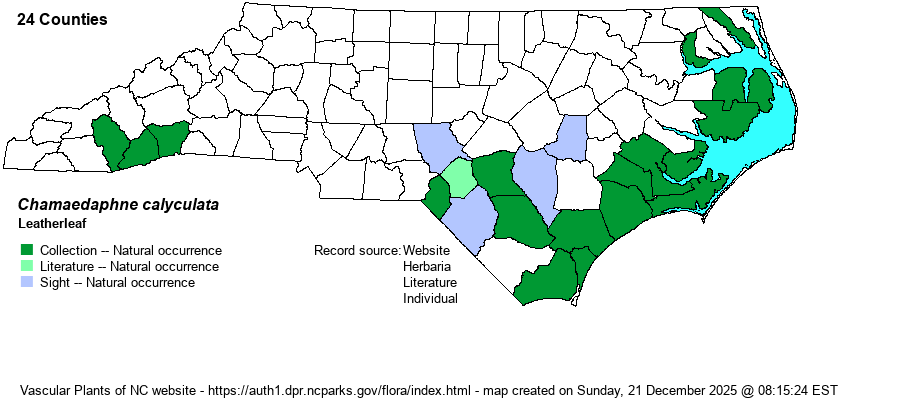| Author | (L.) Moench | |
| Distribution | Scattered over much of the lower and southern Coastal Plain, barely into the Sandhills. Also present at a few locations in the southern Mountains; absent in the Piedmont.
This is a species of the far North, ranging southward through NJ and most of PA, west to northeastern IN. The species is disjunct southward, not yet known from VA or WV, but oddly does occur in parts of NC and eastern SC (Horry County at least).
| |
| Abundance | Quite local, but can be fairly common in a few places in the Coastal Plain; however, mostly rare to locally uncommon in the southern Coastal Plain, and generally rare in the far eastern Coastal Plain. Very rare in southern Mountain bogs. May occur in large stands in some pocosins. | |
| Habitat | This species is found mostly in pocosins, especially the centers of them, where the vegetation is lower than in the outer portions. Also it occurs in other wet, acidic ground near pocosins or beaver ponds, such as canal margins and ditches. It is found in bogs in the Mountains (and throughout most of its range). | |
| Phenology | Blooms in March and April, rarely in February; fruits from July to October. | |
| Identification | This is a knee-high, evergreen shrub that usually grows in moderately dense stands. The leaves are narrowly elliptic or obovate, entire and slightly rolled at the margin, being only 1-1.5 inches long. They are quite thick and leathery, and generally scurfy with many scales above and below; most are ascending on the branches. The plant can usually be identified by the arcing and then horizontally growing branch tips that usually are well-adorned with many small, white urn-shaped flowers, capsules, or flower buds. Some such reproductive parts are seen on most plants at all times of the year. To see this species closely, such as to obtain photos, you may well have to get your feet wet or muddy. | |
| Taxonomic Comments | The species was formerly known as Cassandra calyculata. The species is monotypic in its genus and has no obvious close relatives. Some authorities have assigned varieties, but this is not generally supported.
| |
| Other Common Name(s) | Cassandra | |
| State Rank | S3 | |
| Global Rank | G5 | |
| State Status | | |
| US Status | | |
| USACE-agcp | OBL link |
| USACE-emp | OBL link |

